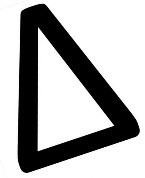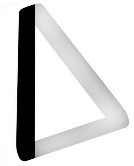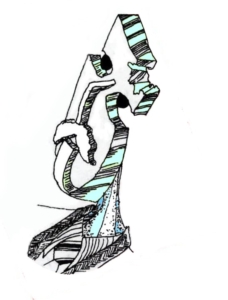Sound: [d]
Signifying:
- (formally) sharp or shrply bending
- (as action) [of] crucial nature
- (functionally) certain
[d] sound in Türki is equal to the sound of [d] as in ‘door’ in English.
Place of articulation: blade of tongue pressing against the ridge
manner of articulation: stop/plosive
voiced/voiceless: voiced
The significance of the sound [d]
This sound could be considered as one of the first four prominent stop sounds as found in the first phonetic alphabet of Ugarit (around 1400 BCE [3400 years ago]). Theoretically it conveys some complex but prominent concept. The order with Ugarit alphabet continued with Greek alphabet and Arabic alphabet. In Ugarit alphabet the letter _standing for the sound [d]_ is called delt meaning ‘door’.
Our studies show that the early sounds were of semiotic value. Therefore, we use signify (instead of sign) for the sounds. The semiotic value of the stop sound [d] is:
-
-
- (formally) sharp or shrply bending
- (as action) [of] crucial nature
- (functionally) certain
-
Graphic figure as a sign (icon)
Graphic shape of the sound [d] in Greek alphabet (as an icon [primary level of signs] in semotics) shows the same presumed signification with the sound ‘a phenomenon which is sharp/sharply bending, crucial, certain’:
 This graphic icon comprises a vertical main body corpus:
This graphic icon comprises a vertical main body corpus:
 And a sharply bending part on the main body:
And a sharply bending part on the main body:
 Shape of Γ in its sign-signify value
Shape of Γ in its sign-signify value
This graphic shape as a signifier signifies the concept of ‘[an organ/phenomenon] sharp or sharply bending on main body’.
Even the graphic shape of the same sound on Arabaic alphabet is signifying the same:
![]() Examples:
Examples:
Body organs sprouting out of main body:
![]() 1. .Daban (heel), 2. Diz (knee), 3. Dirsək (elbow), 4. Donbalmaq (to bend and bring up the hip)
1. .Daban (heel), 2. Diz (knee), 3. Dirsək (elbow), 4. Donbalmaq (to bend and bring up the hip)
![]() 5. Dırnaq (hoof/nail), 6. Dimdik (beak), 7. Diş (tooth/fang), 8. Dağ (mount/mountain)
5. Dırnaq (hoof/nail), 6. Dimdik (beak), 7. Diş (tooth/fang), 8. Dağ (mount/mountain)
